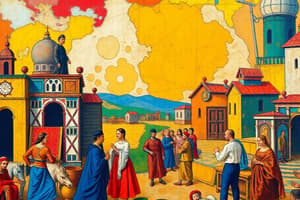Podcast
Questions and Answers
What was a major characteristic of the Renaissance period?
What was a major characteristic of the Renaissance period?
- A significant decline in population due to plagues
- The solidification of feudal systems across Europe
- A cultural and intellectual movement marked by humanism (correct)
- A focus on isolationist policies among European nations
What role did maritime advancements play in European exploration?
What role did maritime advancements play in European exploration?
- They allowed for more efficient trade strategies with Asia.
- They primarily facilitated local fishing practices in Europe.
- They enabled longer sea voyages and improved navigation. (correct)
- They reduced the need for land-based routes in trade.
Which of the following empires was NOT part of the major Islamic Empires that controlled trade routes?
Which of the following empires was NOT part of the major Islamic Empires that controlled trade routes?
- Safavid Empire
- Ottoman Empire
- Mughal Empire
- Ming Dynasty (correct)
What was a key feature of the Trans-Saharan trade network?
What was a key feature of the Trans-Saharan trade network?
What was one effect of European colonization on Amerindian populations?
What was one effect of European colonization on Amerindian populations?
How did cultural disruption manifest among indigenous populations during colonization?
How did cultural disruption manifest among indigenous populations during colonization?
What does cultural resilience refer to in the context of Amerindian societies?
What does cultural resilience refer to in the context of Amerindian societies?
Which of the following best describes the adaptation of Amerindian societies during colonization?
Which of the following best describes the adaptation of Amerindian societies during colonization?
Flashcards
Renaissance
Renaissance
A period in European history (14th century onward) marked by significant advancements in art, science, and exploration, fueled by renewed interest in classical knowledge.
Maritime Advancements
Maritime Advancements
Innovations in shipbuilding and navigation, such as the caravel and compass, that allowed European explorers to venture across oceans and establish trade routes.
Islamic Empires
Islamic Empires
Powerful empires (Ottoman, Safavid, Mughal) that spanned vast territories, controlled important trade routes, and facilitated the exchange of goods, ideas, and technology between regions.
Ming Dynasty
Ming Dynasty
Signup and view all the flashcards
Trans-Saharan Trade
Trans-Saharan Trade
Signup and view all the flashcards
Aztec and Inca Civilizations
Aztec and Inca Civilizations
Signup and view all the flashcards
Global Exchange
Global Exchange
Signup and view all the flashcards
Population Decline
Population Decline
Signup and view all the flashcards
Study Notes
Renaissance and Global Interactions
- The Renaissance, a 14th-century European movement, spurred advancements in art, science, and exploration.
- Maritime advancements like the caravel and compass facilitated exploration and trade.
- Powerful Islamic empires (Ottoman, Safavid, Mughal) controlled major trade routes, fostering exchange.
- The Ming Dynasty in China (1368-1644) prioritized stability and maritime trade, influencing East Asia.
- Trans-Saharan trade connected African kingdoms (Mali, Songhai) with North Africa and Europe, exchanging gold, salt, and culture.
- The Aztec and Inca empires developed intricate societies but remained isolated from Afro-Eurasian networks.
- Global exchange intensified in the 15th century through trade, conquest, and cultural diffusion.
Impact of European Contact on the Americas
- European diseases devastated indigenous populations, causing significant decline.
- Warfare and forced labor systems further reduced Amerindian populations.
- Colonization disrupted traditional Amerindian cultures with European religions, languages, and customs.
- Indigenous peoples fought back, like in the Pueblo Revolt of 1680.
- Amerindian societies adapted to European presence by taking on new tools and practices.
- Despite challenges, Amerindian cultures persisted, showcasing resilience and preservation of traditions.
- European colonization led to the appropriation of indigenous lands for settlement and resource extraction.
Studying That Suits You
Use AI to generate personalized quizzes and flashcards to suit your learning preferences.




